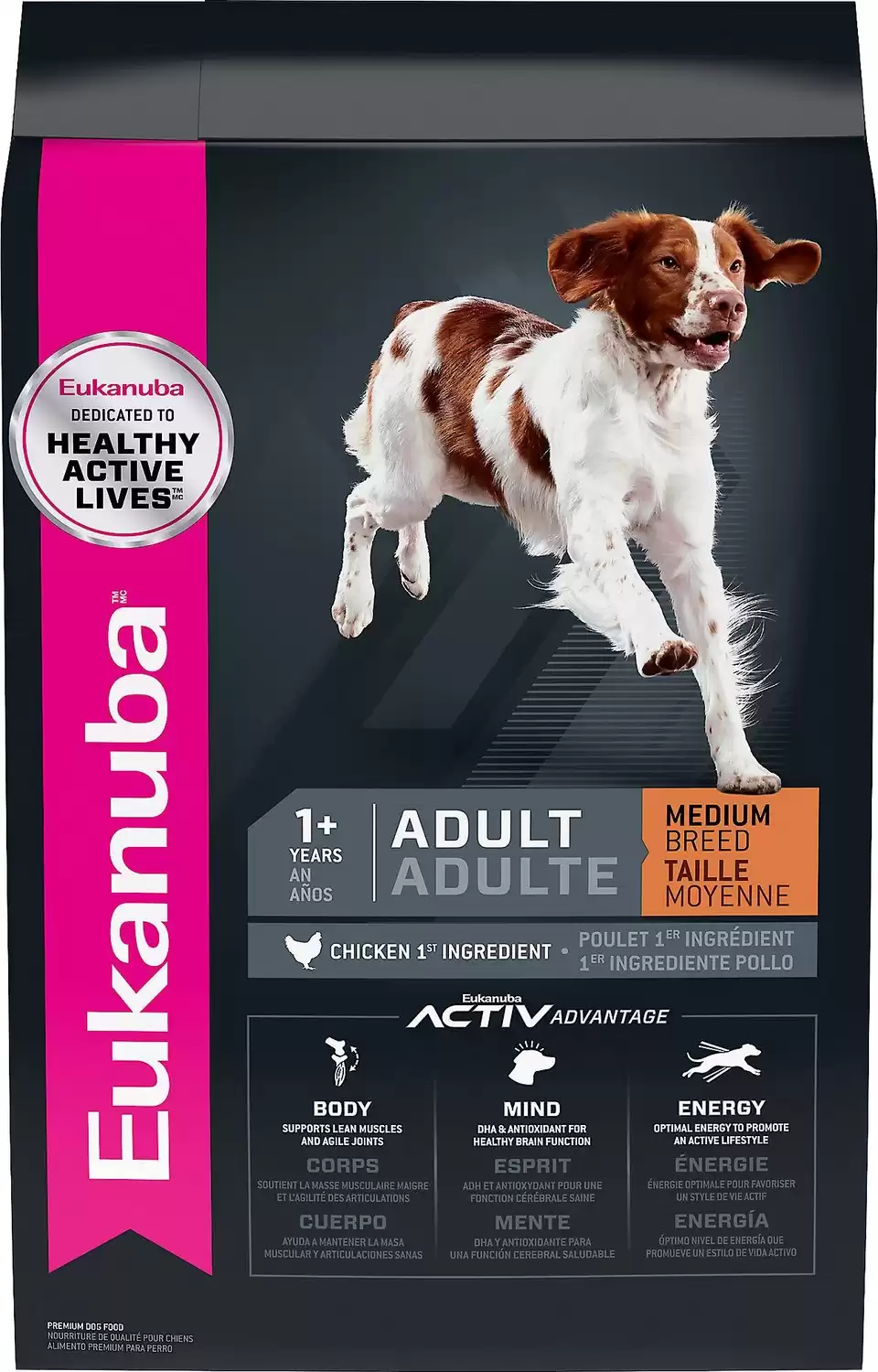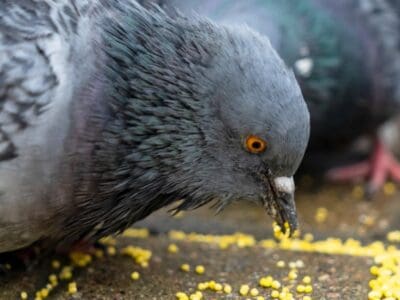Finnish Spitz
Canis lupus
Likes to bark a lot!
Advertisement
Finnish Spitz Scientific Classification
- Kingdom
- Animalia
- Phylum
- Chordata
- Class
- Mammalia
- Order
- Carnivora
- Family
- Canidae
- Genus
- Canis
- Scientific Name
- Canis lupus
Read our Complete Guide to Classification of Animals.
Finnish Spitz Conservation Status
Finnish Spitz Facts
Finnish Spitz as a Pet:
- General Health
- Energy Level
- Shedability
- Trainability
- Intelligence
- Tendency to Chew
- Size
- Family and kid friendliness
- Yappiness / Barking
- High
- Separation Anxiety
- Moderate
- Preferred Temperature
- Cold climate
- Exercise Needs
- High
- Friendly With Other Dogs
- Moderate
- Pure bred cost to own
- $1,000 to $2,000
- Dog group
- Non-sporting
- Male weight
- 25-33 lbs
- Female weight
- 20-28 lbs
This post may contain affiliate links to our partners like Chewy, Amazon, and others. Purchasing through these helps us further the A-Z Animals mission to educate about the world's species.
View all of the Finnish Spitz images!
This medium-size breed makes a good family dog and is very friendly and playful.
Origin and History
Finnish Spitzes are believed to have originated from the spitz dogs brought from central Russia by migrants who moved to present-day Finland about 3,000 years ago. Originally bred to hunt game, they are also good companions for other hunting trips, such as hunting elk.
See all of our expert product reviews.
As the breed became less pure due to crossbreeding with other hunting dogs as more and more people traveled to and from Finland, a Finnish man named Hugo Roos wanted to preserve their pure spirit and characteristics. He was able to accomplish this feat over thirty or so years, and the breed as we know it today comes from his original dogs.
In 1979, Finnish Spitzes were named the National Dog of Finland.
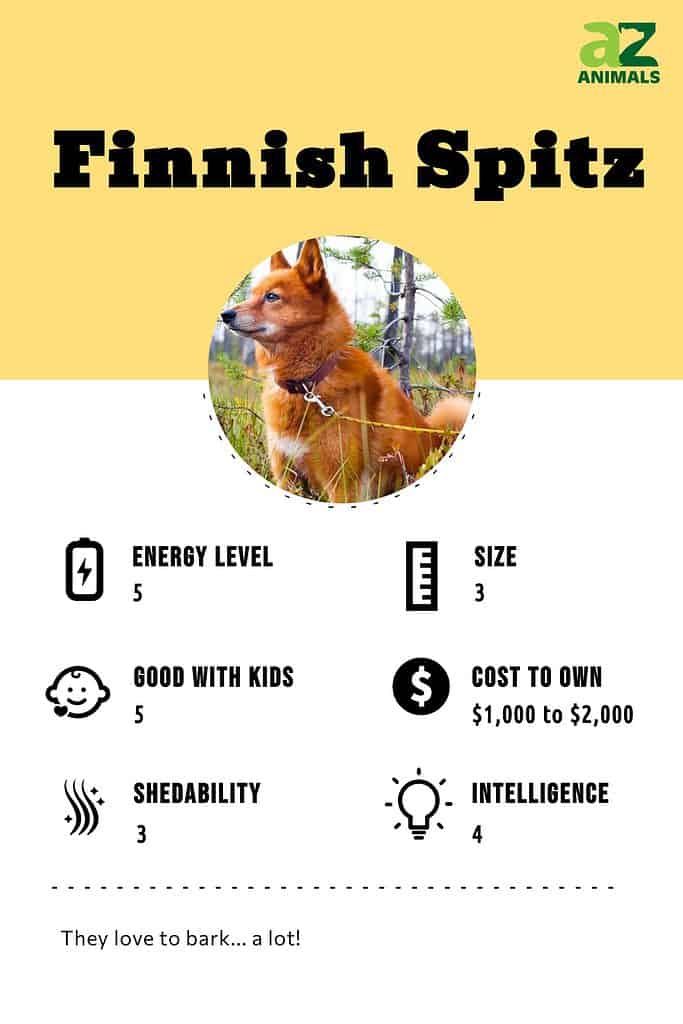
Ownership: 3 Pros and Cons
| Pros! | Cons! |
|---|---|
| Great family pet: Finnish Spitzes can make an excellent family pet. They are friendly and gentle with children. | Barking: Finnish Spitzes are known for barking a lot. When hunting, they bark to point out prey, but the barking transfer over to their day-to-day behavior around the house as well. |
| Playful: Finnish Spitzes love playing with the members of their families. | Strong-willed: Finnish Spitzes can be very strong-willed, which can make them more of a challenge to train than other breeds. |
| Healthy: Overall, the Finnish Spitz is a healthy breed. | Heavy shedders: This breed is known for shedding pretty heavily in the spring and fall and will need extra brushing sessions. |

Finnish Spitzes can be very strong-willed, which can make them more of a challenge to train than other breeds.
©rodimov/Shutterstock.com
Size and Weight
The Finnish Spitz is a medium-sized dog breed. Males are between 17.5 and 20 inches tall and weigh between 25 and 33 pounds. Females are between 15.5 and 18 inches tall and weigh between 20 and 28 pounds. Three-month-old puppies generally weigh between 7 and 16 pounds. Puppies that are 6 months old weigh between 12 and 29 pounds. A Finnish Spitz will be finished growing when they are between 14 and 16 months old.
Health and Entertainment for your Finnish Spitz
See all of our expert product reviews.
| Height (Male) | 17.5 inches to 20 inches |
| Height (Female) | 15.5 inches to 18 inches |
| Weight (Male) | 25 pounds to 33 pounds |
| Weight (Female) | 20 pounds to 28 pounds |
Common Health Issues
There are a few health concerns to be on the lookout for when you bring home a Finnish Spitz. Some of these are genetic conditions, which is why It is very important to work with a reputable breeder if you plan to purchase a Finnish Spitz. Always request health information about the puppy’s parents.
These dogs may suffer from bleeding disorders. Two diseases they are more prone to than other dog breeds include Hemolytic Anemia and Thrombocytopenia. With these diseases, the dog’s immune system starts attacking the red blood cells or plates in the body. This can cause the dog to become lethargic and anemic. They will need immediate veterinary care to diagnose and treat the disorder. Treatment may involve steroids or a blood transfusion.
Eye conditions are another hereditary condition that some of these dogs may have. One condition they may suffer from is cataracts. Cataracts can lead to blindness and may require surgery. Glaucoma is another possible eye disease a Finnish Spitz may suffer from. Without proper treatment, glaucoma can lead to blindness. If you suspect your dog has glaucoma call your vet right away. Symptoms of glaucoma include watery eyes, squinting, or redness in the whites of the eyes.
These dogs can also develop hip or elbow dysplasia. These genetic conditions make it so a dog’s joints don’t develop properly. This can lead to lameness in the legs, difficulties with walking, or trouble getting up. Sometimes surgery may be necessary to treat hip or elbow dysplasia.
To recap, here are some of the potential health concerns these dogs may face:
- Bleeding disorders like Hemolytic Anemia or Thrombocytopenia
- Cataracts
- Glaucoma
- Hip Dysplasia
- Elbow Dysplasia
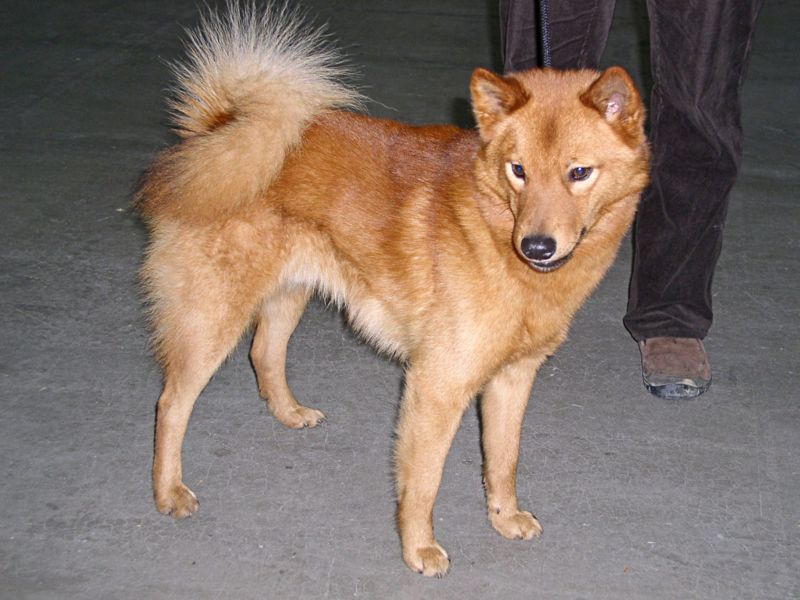
It is very important to work with a reputable breeder if you plan to purchase a Finnish Spitz to find out about any potential genetic conditions.
©PrzemekL – Public Domain
Temperament and Behavior
The Finnish Spitz is a very active breed that requires lots of physical activity each day. They can be very good family dogs because of their personality traits; they are very playful but aren’t overly assertive or aggressive with children like some other breeds. Another positive personality trait of this breed is their overall friendliness, especially toward the people they know and trust.
These dogs are also very protective of their families. Males may exhibit more assertive or domineering behaviors than females if they feel threatened by another dog or person.
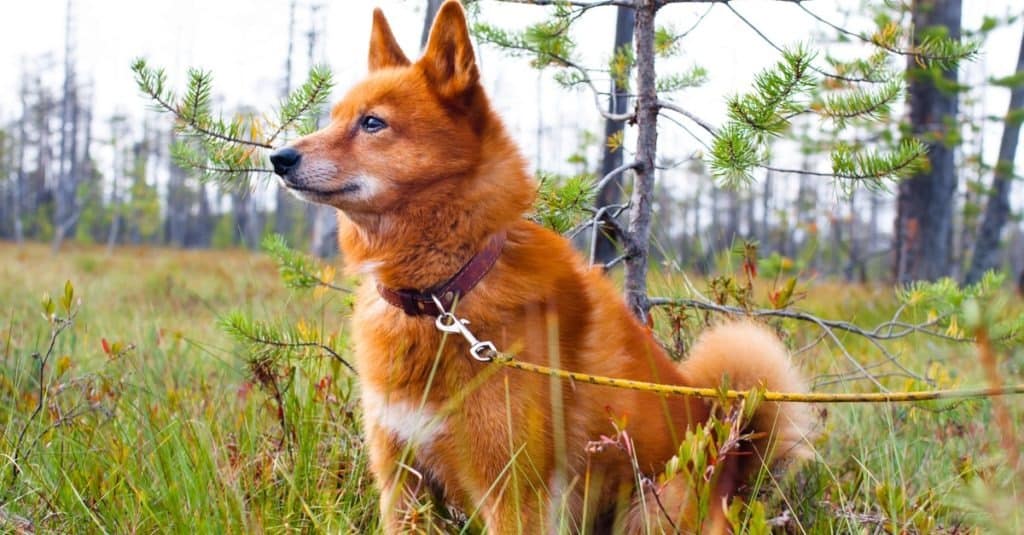
Finnish Spitz can be very good family dogs because of their personality traits; they are very playful but aren’t overly assertive or aggressive with children like some other breeds.
©rodimov/Shutterstock.com
How to Take Care of One
These dogs are different from other breeds and will require a unique care plan. Keep the breed’s potential health concerns, dietary needs, exercise requirements, temperament, and other factors in mind.
The Best Dog Food for Them
When planning a diet for your dog, look for high-quality foods. Look for options that include vegetables, fruits, and proteins to meet this breed’s nutritional needs. Finnish Spitzes can be more prone to obesity than some other breeds, so it is important to make sure you don’t overfeed them. Most will need to eat between 1.75 and 2.5 cups of food each day. Their food should be divided into two meals.
It’s not going to totally stop this dog from shedding so much, but if your Finnish Spitz’s shedding is out of hand, try a specialized dog food to control shedding. Check with your veterinarian if you are not sure how much food your dog should get as the amount can vary based on activity level, age, weight, health concerns, and other factors.
At A-Z Animals, our choice for the best Finnish Spitz dog food is Eukanuba Adult Medium Breed Dry Dog Food.
The natural animal protein ingredients like real chicken are a great source of glucosamine and chondroitin sulfate to help stave off joint problems like hip and elbow dysplasia. Additionally, the power combo of taurine of beta-carotene keeps the eyes in healthy shape to mitigate the risk of cataracts and glaucoma.
Check Chewy or Amazon for this product.
- Adult medium breed dry dog food formulated with complete and balanced nutrition for medium breed dogs over 12 months old and weighing between 24-54 lb.
- Promotes lean muscle development and joint health in active adult dogs with a combination of animal protein, glucosamine, and chondroitin sulfate.
- Helps keep dogs sharp and supports healthy brain function with DHA and vitamin E.
- Fuels an active lifestyle with optimal levels of fats and carbohydrates.
- High-quality chicken is the first ingredient for protein that powers his day.
Since puppies have smaller stomachs, they should be fed more often than adults. Very young puppies may need to eat four times a day, while slightly older puppies should be fine with three meals a day. By the time the puppies are six months old, two meals each day should be sufficient. Choose high-quality puppy food and check with your veterinarian if you’re not sure how much or how often your puppy should be eating.
Maintenance and Grooming
These dogs are relatively easy to groom and maintain. Their coats do not require any trimming, aside from the feed. They will need to be brushed every few days using a pin brush. However, during their shedding seasons, they will require daily brushing to keep the shedding at bay. They can be heavy shedders during these seasons, and this is especially true for females who have not been spayed.
The dog’s teeth should be brushed a few times a week to prevent tartar from building up or turning into dental disease. They should also have their nails trimmed to keep them from causing the dog pain as they walk.
Training
This breed can be very strong-willed and independent, which can make them more of a challenge to train. They are also intelligent, which leads them to get bored more easily. To train a Finnish Spitz, you’ll want to use positive training methods, keep each session short, and engage your dog in different exercises and activities to keep the training interesting for them.

Finnish Spitzes can be very strong-willed and independent, which can make them more of a challenge to train.
©iStock.com/PavelRodimov
Exercise
These dogs have a relatively high need for exercise. They should be given daily opportunities to go for a long walk with their owner, play a game of fetch, or run around in a fenced-in yard.
Puppies
If you’re getting ready to purchase a Finnish Spitz from a breeder or bring one home from an animal shelter, make sure your home is set up and ready for a dog. Purchase a dog bed, toys, leash, collar, food, crate, treats, and other supplies you’ll need for your pup. You’ll also want to find a veterinarian you can trust with caring for your dog.
Remove any potentially hazardous materials from the areas in your home your dog will be able to access. You’ll also want to remove any personal items that you wouldn’t want to see destroyed by a new puppy. Once you bring your dog home, start training and socializing them right away; this breed can be very stubborn, so training for a very young age is highly recommended.
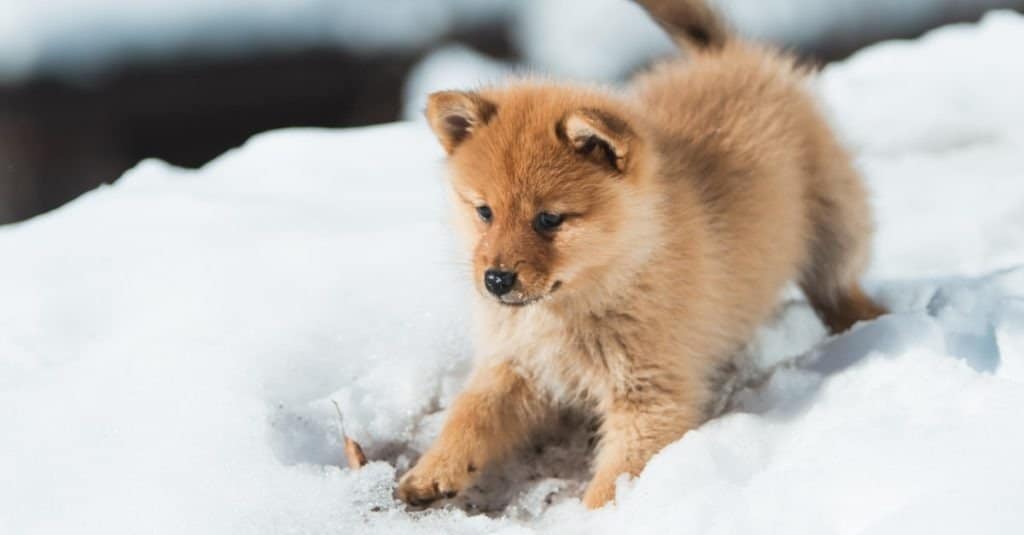
Once you bring your dog home, start training and socializing them right away; this breed can be very stubborn, so training for a very young age is highly recommended.
©Sami Takarautio/Shutterstock.com
With Children
These dogs make very good family dogs. They are loving and very tolerant of children. Finnish Spitzes also generally know when to walk away if a child is doing something they don’t like, compared to some other breeds that may snap at the child. While they are generally good with children, it is always recommended to closely supervise children when they are with this breed, as is the same with other breeds. This is especially true with younger children who don’t yet know how to properly interact with a dog.
Similar Dogs
American Eskimo Dogs, Shiba Inus, and Chow Chows are three dog breeds that are similar to these dogs.
- American Eskimo Dog: American Eskimo Dogs (standard-size) and Finnish Spitzes are similar in size. Both are medium dog breeds with an average weight of around 30 pounds (16 pounds for American Eskimo Dogs and 33 pounds for Finnish Spitzes). Both breeds can also be playful and affectionate. These breeds have a very different look, though. While Finnish Spitzes are reddish gold in color, American Eskimo Dogs are white.
- Shiba Inu: Shiba Inus and Finnish Spitzes both have relatively easygoing personalities and can be good dogs for first-time owners. Both breeds have a high energy level and require a good amount of exercise. Finnish Spitzes are more vocal than Shiba Inus and more likely to bark.
- Chow Chow: Chow Chows and Finnish Spitzes are both very loyal and independent breeds. Chow Chows are larger than Finnish Spitzes, though. Their average weight is 57.5 pounds, while the average weight of a Finnish Spitz is just 33 pounds.
Popular Names for Them
Below are some popular names for these dogs. You may find the perfect name for your new pup.
- Toby
- Leo
- Bailey
- Riley
- Oliver
- Molly
- Ginger
- Bella
- Zoey
- Ruby
Finnish Spitz FAQs (Frequently Asked Questions)
Are Finnish Spitzes herbivores, carnivores, or omnivores?
Finnish Spitzes are Omnivores, meaning they eat both plants and other animals.
What Kingdom do Finnish Spitzes belong to?
Finnish Spitzes belong to the Kingdom Animalia.
What class do Finnish Spitzes belong to?
Finnish Spitzes belong to the class Mammalia.
What phylum to Finnish Spitzes belong to?
Finnish Spitzes belong to the phylum Chordata.
What family do Finnish Spitzes belong to?
Finnish Spitzes belong to the family Canidae.
What order do Finnish Spitzes belong to?
Finnish Spitzes belong to the order Carnivora.
What type of covering do Finnish Spitzes have?
Finnish Spitzes are covered in hair.
What genus do Finnish Spitzes belong to?
Finnish Spitzes belong to the genus Canis.
What is an interesting fact about Finnish Spitzs?
The Finnish Spitz likes to bark a lot!
What is the scientific name for the Finnish Spitz?
The scientific name for the Finnish Spitz is Canis lupus.
What is the lifespan of a Finnish Spitz?
The average lifespan of a Finnish Spitz is between 13 and 15 years.
How much does a Finnish Spitz cost to own?
Finnish Spitzes are rarer than other dog breeds in the United States and may have a larger price tag than some other breeds because of this. The price you should expect to pay to purchase a Finnish Spitz from a breeder is between $1,000 and $2,000. Adopting a Finnish Spitz from a rescue organization will be cheaper and should probably cost around $200.
Don’t forget about the additional price you’ll need to pay for owning a dog. This about expenses such as veterinary care, food, supplies, and training. Budget between $1,000 and $1,500 for the first year you own your dog and between $500 and $1,000 for each other year.
Is a Finnish Spitz good family dogs?
Yes, Finnish Spitzes are generally very good with kids. This breed is loving, playful, and very tolerant around children.
Can a Finnish Spitz swim?
Yes, many Finnish Spitzes can swim. The breed is very active and loves the water, so your Finnish Spitz will likely enjoy swimming.
Are Finnish Spitz dogs aggressive?
In general, Finnish Spitzes are not aggressive dogs. They are very friendly with the people they trust and more reserved around strangers. However, they may become aggressive around another dog they do not know.
Where can I buy a Finnish Spitz?
If you are looking to purchase a Finnish Spitz, check with local rescue organizations or look for breeders that offer Finnish Spitzes. The Finnish Spitz Club has a list of breeders in good standing with the club, meaning they are more trusted. However, before purchasing a Finnish Spitz from one of these breeders, or other breeders, it is important to do your research and make sure the breeder is reputable and trustworthy.
Thank you for reading! Have some feedback for us? Contact the AZ Animals editorial team.
Sources
- American Kennel Club, Available here: https://www.akc.org/dog-breeds/finnish-spitz/
- Wikipedia, Available here: https://en.wikipedia.org/wiki/Finnish_Spitz
- Petfinder, Available here: https://www.petfinder.com/dog-breeds/finnish-spitz/
- Hill's Pet, Available here: https://www.hillspet.com/dog-care/dog-breeds/finnish-spitz
- Belpatt, Available here: https://en.belpatt.fr/puppy-weight-chart/Spitz
- Finnish Spitz Club, Available here: http://www.finnishspitzclub.org/breeders.html
- Humble Dogs, Available here: https://humbledogs.com/can-a-finnish-spitz-swim/
- Doggie Designer, Available here: https://doggiedesigner.com/finnish-spitz/






